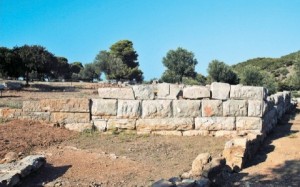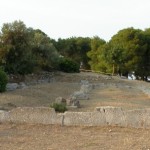The Sanctuary of Poseidon is an Archaic temple located on a rolling peak on the eastern section of the island, roughly 11 kilometers from the town.
Discovered in 1894 by the Swedish archaeologists Samuel Wide and Lennart Kjellberg, the sanctuary’s ruins were not studied further until 1997, when the Swedish Institute in Athens was granted permission by the Greek state to excavate the site. Preliminary excavations yielded sufficient evidence to create computer-generated plans of the Sanctuary, including the Asklepieion and subsequently Heroon of Demosthenes. The site has also been cleared of surface rubble so that the foundations and basic outlines of the temple’s buildings are in plain sight. Variations in the types of stone used to build the temple suggest the sanctuary was expanded over a period of two or three centuries.
Located on the outskirts of ancient Calauria, the Sanctuary of Poseidon has a commanding view of the Saronic bay. It was most likely the meeting place of the amphictyony, a shared ruling council formed by a group of cities with similar or allied interests.
The sanctuary’s main temple rose in the northeast, at the end of a stoa and a small agora to the west. A Doric periptero six columns wide and 12 columns long hemmed the Ionic temple. Entry was through a small pronaos, reached through a slightly elevated platform. A statue of the Poseidon housed inside the temple is believed to have been about five meters tall, based on a section of a foot found at the site.
Foundations of a small, square building on a diagonal from the temple suggest it was the Asklepieion where Demosthenes was buried (In ancient Greece, the heroon was a small area dedicated to a deceased hero). Statuettes of Asklepios, god of healing, were also found in the rubble surrounding it. The site has yielded few finds: some pot sherds from the fourth century B.C. and pieces or fragments from the Mycenaean and Geometric periods. Archaeologists believe the temple was repeatedly plundered; a British traveler in the late 18th century even describes how he watched the marble ruins dismantled and removed to Hydra to be used for the construction of a monastery.
Το Ιερό του Ποσειδώνα στον Πόρο είναι από τα σημαντικότερα μνημεία της αρχαιότητας, με μεγάλη σημασία για τον Πόρο σήμερα.
Οι ανασκαφές που έχουν γίνει μέχρι σήμερα έχουν ήδη δώσει μια πληθώρα εντυπωσιακών ευρημάτων. Ευρήματα που μπορούν μάλιστα να αλλάξουν αυτά που γνωρίζαμε ως τώρα για τη θρησκευτική ζωή στην αρχαία Ελλάδα. Κάθε νέα ανασκαφική περίοδο έρχονται στο φως και νέα δεδομένα, νέες ενδείξεις για τους αρχαίους κατοίκους του νησιού και της γύρω περιοχής, κάποια από τα οποία θα παρουσιάσουμε παρακάτω. Κρίνοντας από τη συχνότητα με την οποία αναδύονται τα νέα ευρήματα, θα μπορούσαμε να πούμε ότι το Ιερό του Ποσειδώνα κρύβει ακόμα πολλές εκπλήξεις για τους αρχαιολόγους αλλά και για τους κατοίκους του Πόρου.
Στο χώρο του Ιερού του Ποσειδώνα δεν υπήρχε μόνο ο ναός του Ποσειδώνα, πασίγνωστος στην κλασσική αρχαιότητα, αλλά και ένα ολόκληρο σύμπλεγμα από βοηθητικά και άλλα κτήρια, τα οποία τον πλαισίωναν. Μάλιστα, τα κτήρια αυτά είναι σήμερα πιο καλοδιατηρημένα από τον ίδιο το ναό, ο οποίος ως γνωστόν δε σώζεται, και μας δίνουν μια πληθώρα πληροφοριών για τον τρόπο με τον οποίον ζούσαν και λάτρευαν οι αρχαίοι Ποριώτες και οι επισκέπτες τους. Όταν αναφερόμαστε λοιπόν στο «ιερό του Ποσειδώνα» εννοούμε όλα αυτά τα κτήρια τα οποία αποτελούν μια μονάδα και έχουν έρθει στο φως σε μεγάλη έκταση χάρη στις προσπάθειες της αρχαιολογικής ομάδας που σκάβει εκεί.




